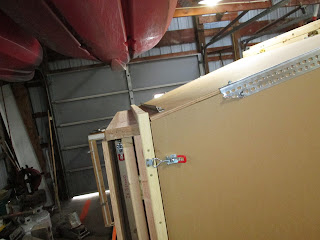Took me about 30 minutes to roll this 12 foot long bad boy out and put the three pieces together.
Just for fun I took a picture with the original 20" box fan and 42" barn fan used for KidWind turbine testing in the past.
So lets go through the steps in putting this together. First I rolled out the 72" Fan unit.
Before I could go any further I needed to attache the chicken wire to the hog panel. This smaller mesh would protect the fan blades from any blades that break off should there be a turbine failure.
Then there was the little detail of sealing the joints between the Connector and the Fan. This was accomplished by stapling a 1/2" foam backer rod to the edge of the 1/2" MDO plywood.
With the backer rod in place you can see how this will seal the hinge joint area.
Now I rolled in the Platform. The Platform has a 2x4 cleat on the back side that will catch the bottom side of the Connector when it is folded down. The cleat stops the bottom side from going to the ground.
Now the bottom side has been lowered and attached to the Platform. The top can be raised up and the sides can be folded out where they will be attached to the angle iron stops.
With the Connector and Platform in place it is time to bring on the Test Chamber. The height of the Platform brings the surface level with the Connector edge.
The Test Chamber is placed on top of the Platform ready to be inserted into the Connector.
When the Test Chamber is in place the draw clamps are latched and an air tight seal is made.
And then the sides and top of the Test Chamber can be unfolded.
And there you have it. One Variable High Speed wind tunnel ready to be powered up. I brought up Don Tuescher from Tuescher Electric that is doing the work on the frequency drive control system to see it. He sets a high bar on safety and professionalism and I wanted to live up to his standards. His control panel and the interlocking safety system is of the highest order. Making the control panel look good and safe with a LOTO protocol was a must. He and his team rose to the challenge and then some. More details and pictures on this to come.

















































